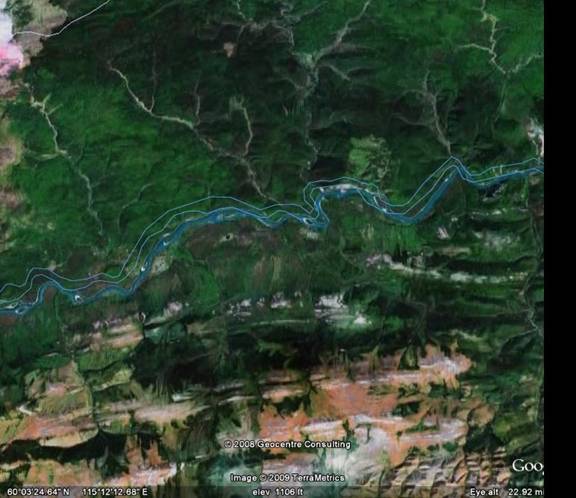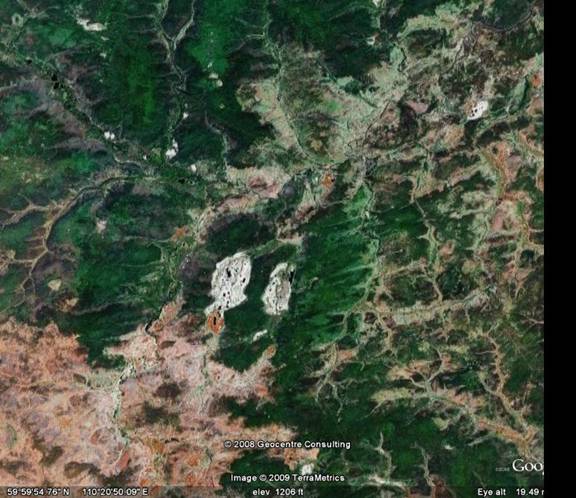
Figure 1. Image from Google earth.
Tunguska. A possible disproof regarding trees:
On October 21, 2008, I suggested that the reason there are more different kinds of trees in tropical forests than in high latitude forests is that like people, trees can only have a finite size of their gene pool. In the tropics, gene pool size is limited by having evolved a large number of different species, so any one species is sparse and can only fertilize a limited number of its own kind. In the far north, where the glaciers have been so recent that there has not been enough time for multiple species to have evolved, the same thing is accomplished by not having an unbroken forest canopy. The trees are distributed along riverbeds and in other desirable places in a sort of frond like pattern with tracts of forest separated by barren space.
There is a way one might test this theory and disprove it. Perhaps the mechanism for some reason does not apply to trees. The test depends critically on that fact that in 1908 in Siberia, there was an enormous explosion. No crater was found (although recently Lake Cheko has been suggested), but ground zero was discovered. The going theory is that some incoming asteroid or comet exploded as it hit the atmosphere. Comets consist largely of water ice; they have been called “dirty snowballs.” Since water has such a small molecular weight it is very effective at turning heat into mechanical force. So a flash of steam makes good sense. The point is that it killed a lot of trees, not to mention whatever hapless people or reindeer may have been there.
The explosion happened about 100 years ago, perhaps time for 3 generations of trees. That is not enough time for excessive population time to express itself in humans and it seems very unlikely that it could have done so in trees. So starting from a completely dead but otherwise exploitable environment, the trees should have swept in and produced an unbroken canopy. There might be some mechanism they have developed to prevent that, but I cannot imagine one. Perhaps they only grow along river beds, but that would mean that riverbeds over an enormous distance would be like other riverbeds but not like the ground only a few feet away. And just possibly there would be a central spot that was barren.
The problem is that I do not know exactly where the air burst took place. If it took place over a barren spot surrounded by confluent forest canopy, that would prove nothing. For instance 60o 5’ 3.95” N 115o 12’ 35.92” E centers on a little lake and the surrounding forest seems unbroken. It could be the site or it could be a flight of fancy.

Figure 1. Image from Google earth.
On the other hand, if ground zero was 60o N 110o E, there the forest looks broken up into the usual frond like pattern. If that were the impact site, it would take a lot of hand waving to argue that the distribution was anything but a result of local factors and the notion that trees, like humans, can only sustain a limited gene pool size would be very dubious.

Figure 2. Image from Google Earth.
Lacking the precise coordinates, I cannot say whether the disproof holds or not. But it is comforting to know that disproof is at least possible. If there is no data that could disprove your theory, then you have no theory.
There have been 720 visitors so far.